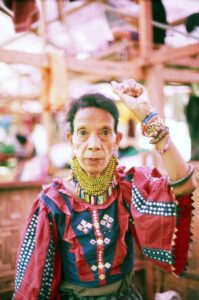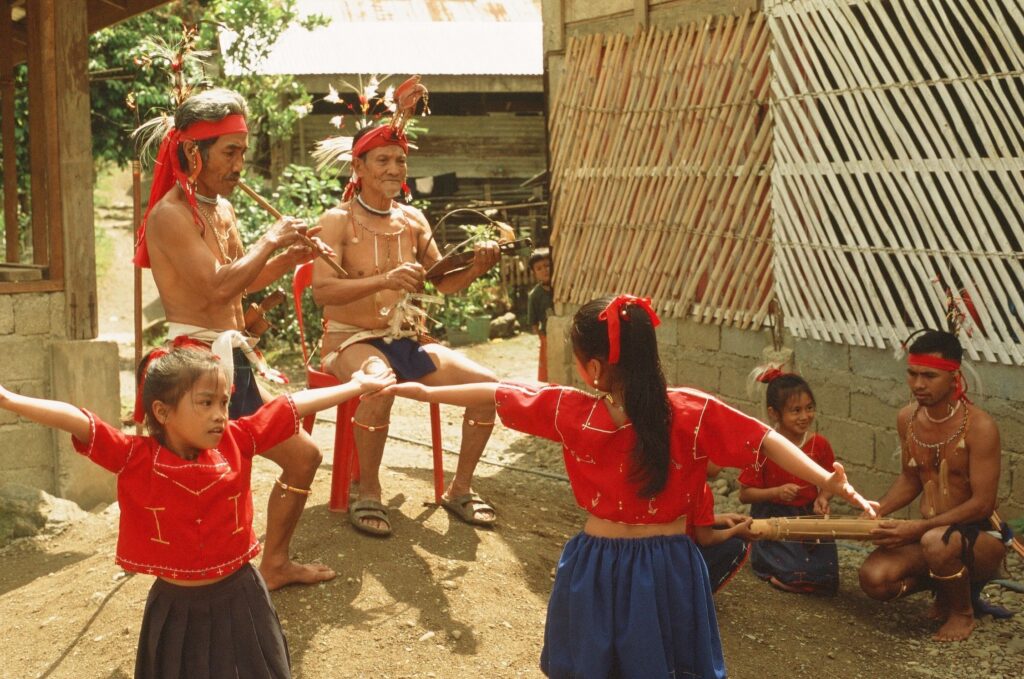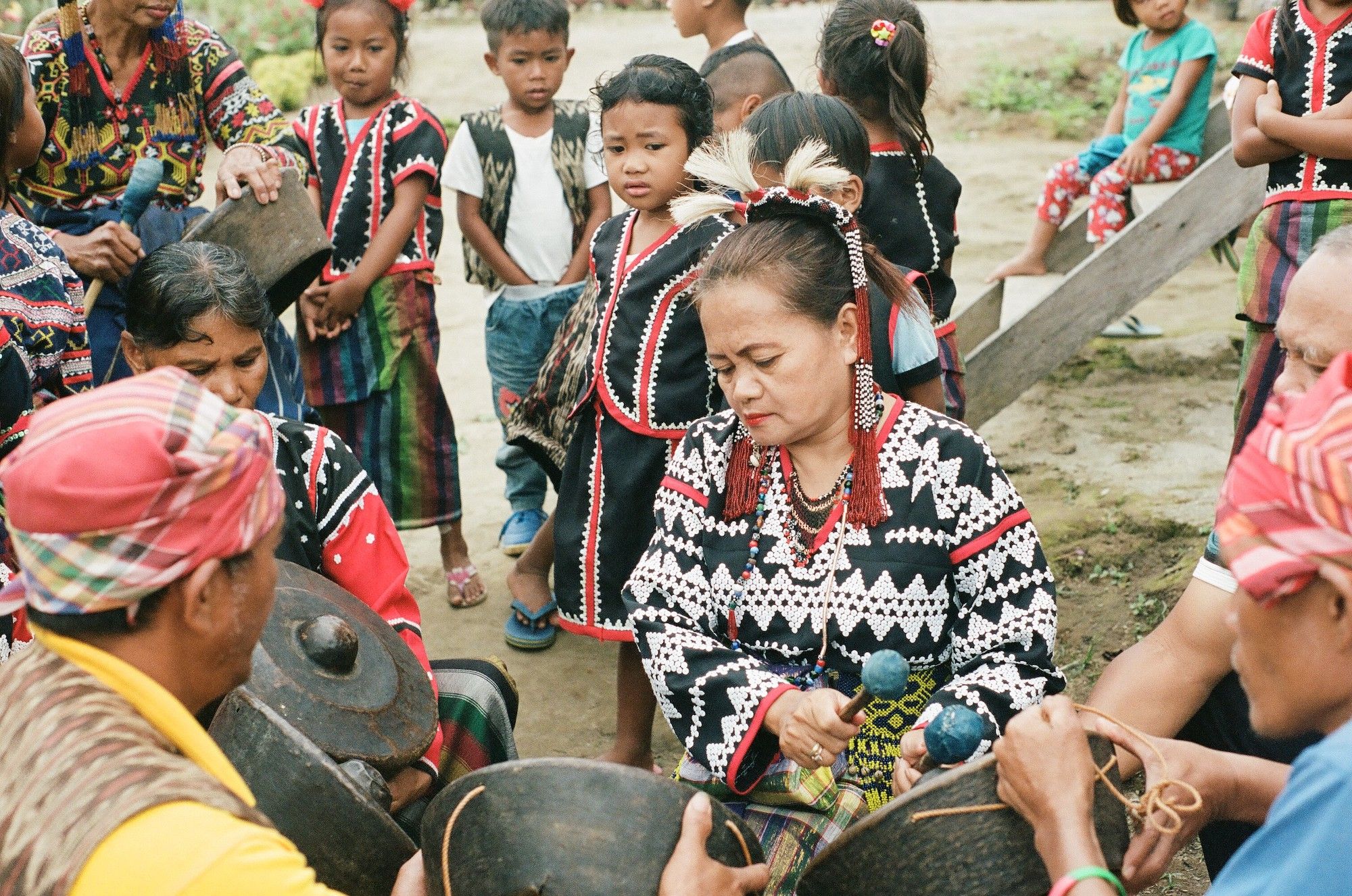Photo by Kim Requesto
[ID: In the center of the photo is Boi Rosie Sula, an elder of the Tboli community in Lake Sebu, known for her powerful chanting. She is surrounded by community members as they hold round brass instruments as she continues to play while younger community members curiously observe.]
Editor’s Note: Requesto is a Spring 2023 CA$H grantee. This article highlights her funded activities and vision.
Rowena Richie: You use photography to, “Visually share the realities of Philippine citizens.” Why do you want to share the realities?
Kim Requesto: When I think of sharing my work with an audience, I hope that everyone, regardless of their race, class, gender, sexuality, and ability, can learn, understand, and find connection. There are so many similarities and parallels to our lives, sometimes it takes art in order for us to see and feel it.
Rowena: What stories do you want your photographs to tell?
Kim: I want them to remind us that Philippine culture and Filipinx’s are more than just the trope of lumpia, boxing and mainstream personalities. To remember the power, we hold—our identities before colonization, imperialism and western influence.
My photos interact with marginalized and Indigenous communities in the Philippines. Many of those communities are in Mindanao, which is considered an unsafe place because of how it has been portrayed in the media. Being able to share snippets of Mindanao, and different communities that have welcomed me with open arms, is important in combating this narrative and the prejudice that many people have felt.

Rowena: What ethical issues do you face with your photography and dance practices?
Kim: Western photography often objectifies Indigenous persons through the lens. It has been important for me to get consent and be cognizant of the language I use surrounding the act of photography. To consider my relationship and connection to the communities as a visitor, but also as a photographer.
I always try to travel with a Polaroid camera to create two photos of a moment: 1 for them, 1 for me. We’ve seen many times in anthropological photographical history, Indigenous people rarely get to see and hold physical photos of themselves. Additionally, not everyone has the privilege to access technology to be able to see uploaded photos.
I’ve visited one family since 2015. On my last visit we were able to compare all the photos from the previous years. Connecting over photos is a big part of why I fell in love with photography.
With dance, I involve my mentors and culture bearers. I share movements that have any hint of a cultural practice in them with my mentors so they can collaborate with me.
My director in Parangal Dance Company, Eric Solano, has had such an influence and impact on my practice. Going on research trips with him and being able to observe how he interacts with the different communities has taught me that cultural dance is community work.
Rowena: Your CA$H-awarded project, Pasalamat Sa Mga Ina, translates to “Thanks to the Mothers.” What’s the significance of mothers in a patriarchal world?
Kim: Both American and Philippine cultures tend to lean heavy towards patriarchy. However, before colonization in the Philippines, women were regarded highly, even held positions of power. They were regarded as equals. It’s time to reclaim that. To remember the power, we hold in the histories of our matriarchal lineage.
Rowena: Your great lola (grandmother) Juana’s memoir dates back to the 1920s. Nearly 100 years later, you’re sharing her stories. Why? What’s the connection to Pasalamat Sa Mga Ina?
Kim: In her memoir, my great lola writes: “I would like to start writing today interesting events that my beloved ones may enjoy reading about, especially when I am already gone.” I want to share this drive of hers to create joy for others. This joy is ours to inherit through shared memory.
Pasalamat Sa Mga Ina stems from this desire of wanting those we love to be happy. It uplifts and honors this—the act and intention of creating joy so that we may remember.
Rowena: What can younger generations learn from your great lola’s memoir?
Kim: The power in our own narratives and our voice. Even in the subtle act of wanting to remember so that those you love remember, too.

Rowena: How do you imagine your legacy inspiring future descendants?
Kim: I hope it inspires folks to archive our personal histories, create more Filipinx diasporic work, and keep to the tradition of passing down our families’ legacies.
Rowena: You describe yourself as a “Philippine born, Mission District-raised Cultural Worker.” As a cultural worker how do you balance empowering marginalized communities of Filipinos with raising awareness outside of the Filipinx community?
Kim: When it comes to cultural work, it’s important to remember that our work intersects with so many different cultures and communities. Dance and photography that uplifts marginalized communities of Filipinos has given cultural entry points to audience members. By sharing my art and speaking on it, I uplift those Indigenous communities while educating others.
Rowena: How can we in the broader Bay Area dance community help you?
Kim: Create more funding opportunities for artists to continue to be able to share and create their work! More opportunities to collaborate with other artists to showcase what we can and have been doing.
Rowena: Anything else you want to add?
Kim: Parangal Dance Company is having our 15th Anniversary show, Paglinang, soon. I’ve been teaching senior citizens Philippine Folk Dance for the past few weeks as part of a SOMA Pilipinas program called Restorative Theater Arts for Seniors (RETAS) and they’ll be performing!
Parangal and SOMA Pilipinas: Paglinang
Sat, Oct 7, 2023 , 2pm and 7pm
Blue Shield of California Theater at YBCA, San Francisco
This article appears in the Fall 2023 issue of In Dance.


